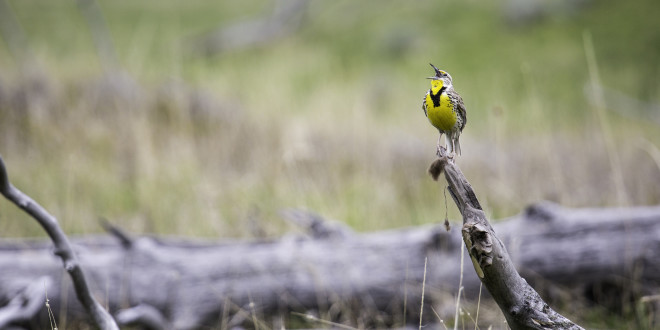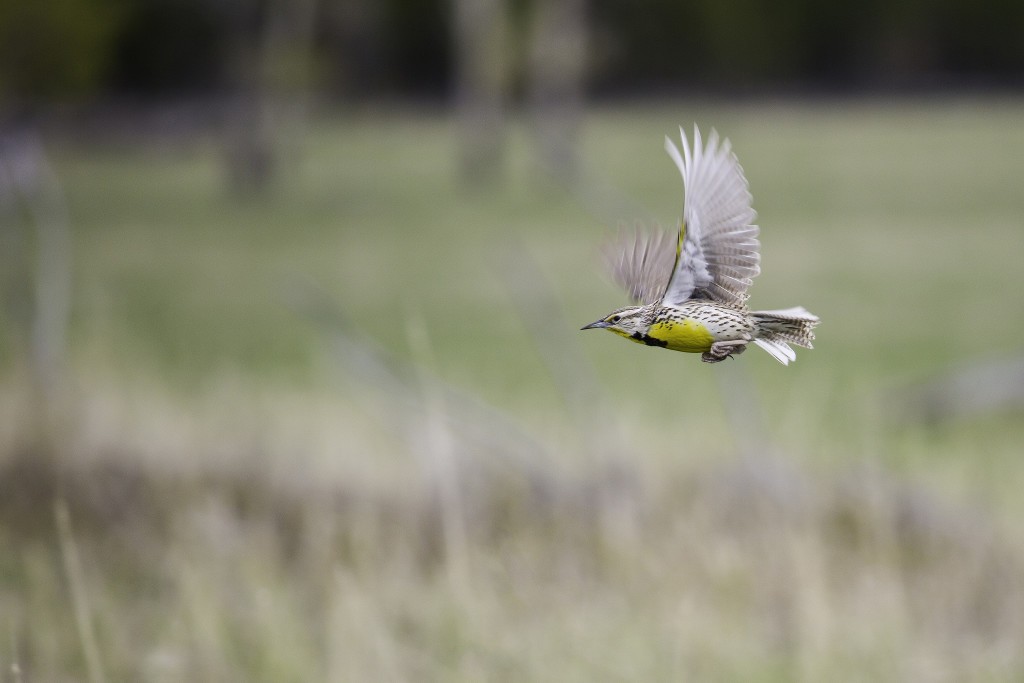The song “Home on the Range” might encompass most people’s conception of Western life, but among its omissions, it’s notably lacking in western meadowlarks.
A supremely beautiful bird, the western meadowlark is a staple of the prairie scene. It’s a quick and lively bird, fluttering through fields and darting through grasses in search of nourishment.
More than likely, you’ll hear a Western meadowlark before you see it, warbling a lovely little symphony. In a region commonly held to be semi-arid, this meadowlark’s call is surprisingly lush.
Basic Facts
- Scientific name: Sturnella neglecta.
- Sturnella translates (roughly) to “starling-like.”
- Neglecta, meanwhile, means “neglected.”
- John James Audubon attributed the scientific name to western meadowlarks, apparently as a dig against other westbound explorers and trappers who ignored this extremely common frontier bird.
- In other words, the western meadowlark is a “neglected starling-like bird.”
- These days, the western meadowlark is the state bird of six states: North Dakota, Oregon, Nebraska, Kansas, Wyoming, and Montana.
- In size, western meadowlarks are roughly the size of American robins.
- Wingspan measures 16.1 inches in both males and females.
- Adults weigh three to four ounces.
Appearance
- In terms of coloring, western meadowlarks have complicated plumage.
- Distinguished by a bright yellow front extending from the head down the body and a V-shaped collar of black.
- Wings appear mottled with buff-gray, black, and white feathers.
- There is subtle variation in coloring between summer and winter, with fall/winter meadowlarks lighter than spring/summer ones.
- Juveniles, for the most part, resemble adult meadowlarks in coloring but are overall duller.
Habitat
- Western meadowlarks are found throughout most of the Midwest, Western United States as well as Canada and Mexico.
- Prefer prairies and grasslands, as well as pasture.
- Western meadowlark range overlaps often with eastern meadowlarks (Sturnella magna).
- For a long time, they were hardly distinguished as separate species, but (as we’ll see below) important differences manifest.
Diet
- Feed on insects like beetles, grasshoppers, crickets, and ants.
- Have been known to feed on snails and spiders as well.
- Western meadowlarks also eat seeds and leftover harvest grain, especially in the fall and winter.
- Feeds by foraging, running its bill along the ground, often in flocks during winter.
Range
- For the most part, western meadowlarks live year-round in California, the Pacific Northwest, Nebraska, Iowa, the American Southwest, western Texas and portions of Mexico.
- Summer ranges include eastern Washington, most of Wyoming, Montana, Minnesota, Wisconsin, Michigan, Alberta, Saskatchewan, and Manitoba.
- Western meadowlarks winter in southern Missouri and Illinois, Arkansas, Louisiana, east Texas, Baja California, and portions of coastal Mexico.
Nesting
- Female western meadowlarks build nests in the ground, scooping up soil with their bills.
- Nests are lined with dry grass and shrub stems.
- Some nests are built to include waterproof dome, anchoring vegetation in the depression.
- An average nest measures roughly seven to eight inches across and two to three inches deep.
- The “cup” or cover measures four to five inches across.
- Western meadowlarks love to build nests in dense vegetation, making them difficult to spot.
- Nests can often be found by following “runways” i.e. paths created by the parents darting to and from the nest.
Courtship
- In spring, males establish territories and defend it by chasing intruders in what is known as “pursuit flights.”
- Males also engage in “jump flights” (springing up and fluttering) while defending territories.
- Males may do this up to a month before a female arrives.
Reproduction
- Male western meadowlarks tend to mate with two females simultaneously.
- Males bring food to the nest and defend against intruders.
- Western meadowlarks have been known to abandon nests if humans discover them, even while incubating eggs.
- Meadowlarks lay five to six eggs, which are white with rust-brown and lavender mottling.
- Eggs incubate 13-16 days.
- Typically meadowlarks have two broods a year.
Young
- Young western meadowlarks are born with closed eyes and pinkish skin.
- Live in the nest for up to 12 days before they can fly.
- Tend to leave the nest after a month.
East & West
- As mentioned, for a long time, eastern and western meadowlarks were not readily distinguished as separate species.
- This is evident in their scientific names, as the eastern meadowlark is known as Sturnella magna or “great starling-like bird” while (as mentioned) the western meadowlark is a “neglected starling-like bird.”
- They are not remarkably separate, as both species have been known to produce hybrids.
- This mix of eastern and western meadowlarks tends to be less fertile than either an eastern or western meadowlark, however.
Sing A (Not So) Simple Song
- The easiest way to distinguish between eastern and western meadowlarks (especially where their ranges overlap) is through their song.
- Eastern meadowlarks have a far simpler song that is more high-pitched.
- Western meadowlarks, on the other hand, have a different tone and warble in more complex, sonorous sequences.
 Yellowstone Insider Your Complete Guide to America's First National Park
Yellowstone Insider Your Complete Guide to America's First National Park







You must be logged in to post a comment.